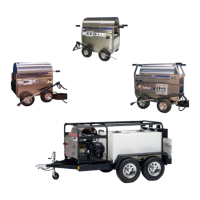POWER SYSTEMS:
ELECTRIC MOTORS: All single
phase electric motors contain a
manual or automatic thermal
overload, which will shut down
the motor if it overheats. If the
overload or starter shuts down the motor, have an
electrician or an authorized Hydro Tek distributor
check for electrical problems. Voltage reading
under load should be +/- 10% of name plate
voltage on motor. Wait for motor to cool before re-
setting. Depressing the red overload button located
on either the motor or the starter can reset the
motor. Use thumb pressure – do not force. If
equipped with an automatic thermal overload, it will
reset itself after the motor has cooled.
Never spray water on the unit, or damage to the
electric motor(s) may occur.
Consult the factory if running an electric machine
from a generator. Three times total system wattage
is required.
A fused disconnect switch of sufficient ampere
rating should be installed by an electrician to
provide power to the machine. Note: 208-230 VAC
rated CN/CW/HN series washers include a control
circuit power selector switch, located on the back of
the control box. Switch it to the appropriate
position to match your source voltage. Switches
are factory set to match recorded test sheet
voltage. Refer to the chart above for electrical
requirements. If your unit is equipped with a
ground fault interrupter, it will have to be reset
whenever it is plugged in, or if a ground fault
interruption occurs. Test regularly for proper
operation.
GASOLINE ENGINE: With the
proper care and maintenance,
your gasoline engine will give
years of trouble free service.
Please follow the Service and
Maintenance Guide and the
enclosed engine sheet or contact your local
authorized engine dealer for maintenance and
repairs.
Use clean, fresh, unleaded gasoline with an octane
rating of 87 or higher in the engine fuel tank. Do
not use unapproved gasoline such as E20 or E85
ethanol blends. Up to 15% MTBE (methyl tertiary
butyl ether) or 10% ethanol is acceptable. Any
failures from use of these fuels will not be
warranted. Consult engine manual for proper oil
type and capacity. The engine manufacturer
recommends a break-in period of 25 hours at which
time the engine oil and filter should be replaced.
Thereafter, change oil every 50 hours and the filter
every 100 hours (see engine manual). Do not rely
on the low oil shutdown (if equipped) as a reminder
to add oil. The engine manufacturer will typically
not warranty engine damage from lack of oil even if
the low oil system failed.
On machines with a 115V generator or a 12V
burner, the throttle is preset at the factory (See
Generator section). Some engines include backfire
prevention solenoids.
DIESEL ENGINE: The diesel engine, although it
has a higher initial cost, can save money with lower
fuel consumption and longer life. Use clean diesel
fuel #2 and do not allow engine to run out of fuel or
the system will have to be bled to restart the
engine.
Clean the fuel filter periodically with kerosene (See
Engine Manual). Use 10w – 30 oil with API
classification CC/CD grade rated for diesel engines
in the engine crankcase and change every 50
hours. If the engine is water cooled, use a 50/50
mix of antifreeze/de-ionized water solution and
check daily. Never use more antifreeze than water
or damage to the engine could occur from
overheating.
POWER TRANSMISSION:
WARNING: Shut off power supply
BELT DRIVE: Check belt condition, alignment and
tension periodically. Replace belts when they show
signs of wear or cracking. Tighten belts by
loosening the mounting bolts on the pump and
generator to permit them to slide. Turn the
horizontal rail adjusting bolts to tighten belts until
they deflect ¼" to ½” with finger pressure.
DIRECT DRIVE: Pump is bolted directly to the
motor/engine. If pump needs to be removed, do
not force off by prying or damage may occur.
When reassembling, coat the entire motor shaft
with heavy grease or a generous amount of anti-
seize and use “thread locker” or “lock tight” on
mounting bolts.
GENERATOR:
Some self-contained hot water
units (SC and SCU Series) are
equipped with a 115v, 2900w
generator to power the diesel

